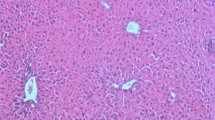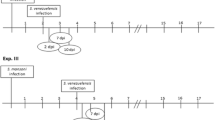Abstract
Schistosoma sp. induced cross-resistance to a challenge withFasciola hepatica andEchinostoma revolutum was studied in mice. Primary patent 56-days-oldS. intercalatum andS. bovis infections stimulated a statistically significant level of resistance to a challenge withF. hepatica, and primary patent 100-day-oldS. bovis infections induced an almost complete resistance to a challenge withE. revolutum. Primary single-sexS. mansoni infections, either male or female, aged 90 days did not stimulate any resistance to a challenge withE. revolutum.
A primary infection withS. mansoni aged 70 days induced a marked reduction (94.1–100%) in theE. revolutum worm recovery already 2 h post-challenge as compared with that of theE. revolutum challenge control group and complete elimination of the echinostome worm population inS. mansoni infected mice had taken place 24 h after challenge.
E. revolutum worm populations established in mice harbouring newly patent 36-day-oldS. mansoni infections persisted unchanged for a period of at least 33 days into the patent period of the schistosome infection in spite of development of a complete resistance to a challenge withE. revolutum metacercariae during this period.
Similar content being viewed by others
References
Christensen NØ, Nansen P, Frandsen F, Bjørneboe A, Monrad J (1978)Schistosoma mansoni andFasciola hepatica: Cross-resistance in mice. Exp. Parasitol 46: 113–120
Dineen JK, Gregg P, Windon RG, Donald AD, Kelly JD (1977) The role of immunologically specific and non-specific components of resistance in cross-protection to intestinal nematodes. Int J Parasitol 7: 211–215
Frandsen F (1979) Discussion of the relationships betweenSchistosoma and their intermediate hosts, assessment of the degree of host-parasite compatibility and evaluation ofSchistosome taxonomy. Z Parasitenkd 58: 275–296
Preston JM, James C (1972) Infection of hamsters with terminal-spined schistosomes. J Helminthol 47: 291–296
Sirag SB, Christensen NØ, Frandsen F, Monrad J, Nansen P (1980) Homologous and heterologous resistance inEchinostoma revolutum infections in mice. Parasitology 80: 479–486
Smithers SR, Terry RJ (1965) The infection of laboratory hosts with cercariae ofSchistosoma mansoni and the recovery of adult worms. Parasitology 55: 695–700
Taylor MG, Nelson GS, Smith M, Andrews BJ (1973) Studies on heterologous immunity in Schistosomiasis. 7. Observations on the development of aquired homologous and heterologous immunity toSchistosoma mansoni in baboons. Bull WHO 49: 57–65
Author information
Authors and Affiliations
Rights and permissions
About this article
Cite this article
Christensen, N.Ø., Nydal, R., Frandsen, F. et al. Further studies on resistance toFasciola hepatica andEchinostoma revolutum in mice infected withSchistosoma sp.. Z. Parasitenkd. 65, 293–298 (1981). https://doi.org/10.1007/BF00926723
Received:
Issue Date:
DOI: https://doi.org/10.1007/BF00926723




